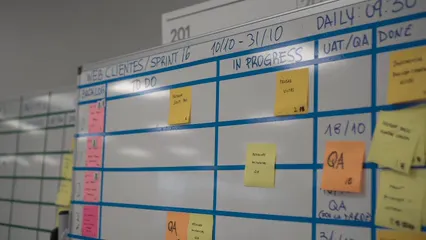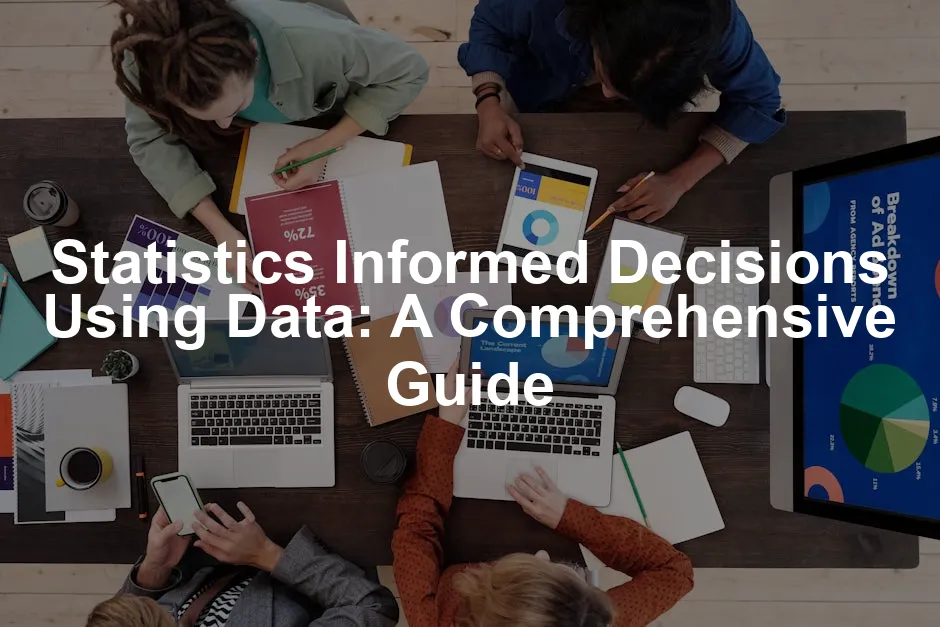Introduction
In today’s fast-paced world, decision-making can feel like a game of chance. Wouldn’t it be nice to have a crystal ball? Well, statistics is the next best thing! Using statistical analysis can transform a guess into an educated decision, whether you’re running a business, working in healthcare, or diving into social sciences. This article discusses the importance of statistics in enhancing decision-making processes across various fields.
Statistics provide a solid foundation for informed choices. By analyzing numerical data, we can identify trends, patterns, and correlations. This allows individuals and organizations to make choices based on evidence rather than gut feelings. For example, in business, companies analyze sales data to predict future trends and adjust strategies accordingly. In healthcare, statistical models help determine the effectiveness of treatments, guiding practitioners in patient care decisions. In social sciences, researchers utilize statistics to understand societal trends and inform policy-making.
In this guide, we’ll cover several key areas: the fundamentals of statistics, the role of data in decision-making, and practical applications across fields. We’ll also explore how statistical knowledge can lead to better outcomes in everyday situations.
Statistics play a crucial role in our daily lives. Take, for instance, the weather forecast. When you check if you’ll need an umbrella, you’re relying on statistical models that analyze past weather patterns to predict future conditions. Similarly, companies use statistics to analyze customer behavior and preferences. This data-driven approach enables them to tailor their products and marketing strategies to meet customer needs effectively.
In summary, statistics are not just for mathematicians and scientists; they are essential tools for making informed decisions in various aspects of life. By embracing statistical concepts, individuals and organizations can navigate the complexities of decision-making with confidence and clarity.

To delve deeper into the foundational aspects of statistics, consider reading an introduction to statistical learning with Python.
Understanding Statistics
What Are Statistics?
Statistics is a branch of mathematics that deals with collecting, analyzing, interpreting, and presenting data. It can be broadly divided into two categories: descriptive statistics and inferential statistics. Descriptive statistics summarize data through numbers, graphs, and charts. For instance, they provide measures of central tendency, such as the mean, median, and mode, helping us understand the data’s general behavior.
On the other hand, inferential statistics allow us to make predictions or generalizations about a larger population based on a sample. For example, if a survey of 500 people indicates that 70% prefer chocolate ice cream, inferential statistics can help estimate that 70% of the entire population might feel the same way.
The importance of statistics cannot be overstated. In economics, statistical analysis helps economists evaluate market trends and consumer behavior. In healthcare, it assists researchers in determining the efficacy of new treatments through clinical trials. Social researchers use statistics to understand demographic shifts, public opinions, and social behaviors.
Statistics act as a bridge between raw data and informed decision-making. By transforming numbers into actionable insights, they empower individuals and organizations to make choices that are grounded in evidence. Whether you’re a data analyst, a business owner, or just curious about the world, a solid understanding of statistics enhances your ability to draw meaningful conclusions from data.
If you want to deepen your understanding of statistics, consider picking up Statistics: Informed Decisions Using Data by Michael Sullivan. It’s a great resource that can help you navigate through the world of statistics with ease!
The Role of Data in Decision-Making
Types of Data
Data comes in two flavors: qualitative and quantitative. Let’s break it down like this: qualitative data is like the colorful sprinkles on a cupcake. It adds flair! This type focuses on descriptions and characteristics. Think of customer feedback, interviews, or open-ended survey responses. It’s all about the “why” behind the numbers.
On the other hand, quantitative data is your reliable cake base. It’s solid, numerical, and can be measured. This includes things like sales figures, test scores, or any data that can be expressed as a number. Both types are crucial. Qualitative data helps you understand the story behind the numbers, while quantitative data provides the numbers themselves. Using both in decision-making? That’s the icing on the cake!
Data Collection Methods
Now, let’s talk about how we gather this precious data. There are several methods, each with its own charm.
1. Surveys: These are the trusty questionnaires that collect data from a group. They can be online, over the phone, or even face-to-face. Surveys help gather opinions, preferences, and behaviors, making them a favorite in market research.
2. Experiments: Want to see cause and effect? Enter the experimental method! Researchers manipulate one variable to see the effect on another. This method is popular in scientific studies and helps in validating hypotheses.
3. Observational Studies: Sometimes, you just need to watch and learn. Observational studies involve watching subjects in their natural environment without interference. This is especially useful in social sciences, where understanding behavior in context is key.
Collecting data through these methods ensures that your decisions are based on solid evidence rather than wishful thinking. So whether it’s a well-crafted survey or a meticulous observational study, the right method can make all the difference in your data-driven decisions.

Making Informed Decisions
Data Analysis Techniques
Descriptive Statistics
Once you’ve gathered your data, it’s time to analyze it. Descriptive statistics are the superheroes of this stage. They summarize and describe the main features of a dataset. Let’s break it down further:
– Measures of Central Tendency: These include the mean (average), median (middle value), and mode (most frequent value). Each measure tells a different part of the story. For instance, the mean can be skewed by outliers, while the median gives a clearer picture of the middle ground.
– Measures of Variability: This includes range (the difference between the highest and lowest values), variance (how far each number is from the mean), and standard deviation (a measure of the amount of variation). These metrics help you understand how spread out your data is, crucial for making informed decisions.
Data Visualization
Now that we have our descriptive statistics, how do we communicate this information effectively? Enter data visualization! Visual representations, such as charts and graphs, transform raw data into digestible insights.
Imagine looking at a spreadsheet filled with numbers. Yawn, right? But a well-designed bar chart or pie chart? That’s eye-catching! Visuals help highlight patterns, trends, and outliers that might not be obvious in raw data. They can also make your findings more accessible to a broader audience.
Good visuals can tell a story, so don’t underestimate their power in decision-making. They not only enhance understanding but also engage the audience. So, whether you’re making a presentation or just trying to make sense of the data, remember: a picture is worth a thousand numbers!
Incorporating these analytical techniques ensures that your decisions are well-informed, precise, and grounded in solid evidence. The combination of descriptive statistics and effective data visualization sets the foundation for impactful decision-making strategies.

Inferential Statistics
For a deeper understanding of the challenges associated with statistical inference, check out the problem with inferential statistics.
Hypothesis Testing
Hypothesis testing is like playing detective with data. You start with a hunch about a population, then test it using a sample. This method allows researchers to make predictions and draw conclusions.
Imagine you own a coffee shop and think your new blend is a hit. You can’t serve every customer to find out. Instead, you sample a group. If the majority rave about it, you can confidently say the blend is popular. But if feedback is mixed, you might need to tweak the recipe.
This process involves setting up a null hypothesis, which assumes no effect or difference, and an alternative hypothesis, which suggests something is happening. By calculating a p-value, you can determine the probability of observing your data if the null hypothesis were true. A low p-value means it’s time to reject the null and accept the alternative hypothesis, giving you the green light to make informed decisions.
Hypothesis testing is crucial in various fields. In healthcare, for example, it helps assess the effectiveness of new treatments. In marketing, it evaluates whether a new campaign increases sales. This statistical tool empowers businesses to make decisions backed by evidence rather than guesswork.
If you’re intrigued by hypothesis testing and want to explore it further, check out Naked Statistics: Stripping the Dread from the Data by Charles Wheelan, a fantastic read that simplifies complex concepts!
Confidence Intervals
Confidence intervals are like a safety net for estimates. They provide a range within which we expect a population parameter to fall. Instead of saying, “The average height of my customers is 5.6 feet,” a confidence interval allows you to express that more accurately: “The average height is between 5.4 and 5.8 feet, with 95% confidence.”
This range comes from sampling. When data is collected, it’s rare that the sample mean perfectly matches the population mean. Confidence intervals take this uncertainty into account, giving a more reliable estimate.
Imagine you’re trying to figure out how much people enjoy your coffee. You survey 100 customers, and their average rating is 4.2 out of 5, with a confidence interval of 4.0 to 4.4. This interval indicates that you can be reasonably sure the true average rating of all your customers falls within those bounds.
Confidence intervals are widely used in fields like finance, healthcare, and social sciences. They help stakeholders gauge the reliability of their estimates and make decisions based on a reasonable understanding of uncertainty. The next time you hear a statistic, ask if it comes with a confidence interval. It’s like knowing the whole picture, not just a snapshot!
Applications of Statistics in Decision-Making
Business and Marketing
Market Research
Statistics play a pivotal role in market research. Companies analyze consumer behavior through surveys and experiments, turning raw data into actionable insights. For instance, a shoe retailer might collect data on customer preferences and purchase patterns to understand which styles are trending.
By using statistical techniques, businesses can segment their market, identify target audiences, and tailor their marketing strategies. Imagine a clothing brand that discovers through data analysis that eco-friendly products appeal to millennials. They can then focus their marketing efforts on sustainable clothing lines, increasing their chances of success.
Market research also helps businesses assess customer satisfaction. By analyzing feedback and ratings, they can identify areas for improvement. A restaurant could use statistics to understand that its customers prefer faster service. Armed with this knowledge, they can optimize their operations to enhance customer experience and boost loyalty.
Sales Forecasting
Sales forecasting is another area where statistics shine. Companies use statistical models to predict future sales and inventory needs. By analyzing historical sales data, trends, and external factors, businesses can make informed decisions about production and staffing.
Consider a toy manufacturer gearing up for the holiday season. By examining past sales data, they can forecast demand for popular toys. If data indicates that certain toys sold out last year, they can ramp up production. This proactive approach minimizes the risk of running out of stock and missing out on sales.
Statistical models also help in identifying seasonality and cyclical trends. For example, a clothing retailer might notice that sales of winter coats spike every November. This insight allows them to plan promotions and inventory accordingly, optimizing their profits during peak seasons.
In summary, leveraging statistics in business and marketing not only enhances decision-making but also drives growth. From understanding consumer preferences to accurately forecasting sales, businesses can make strategic choices that lead to success. So, next time you encounter a statistic, remember: it’s not just a number; it’s a key to unlocking informed decisions!

Healthcare
Clinical Trials
Statistics serve as the backbone of clinical trials. These trials are essential for evaluating new treatments. Without solid statistical design, the results could be misleading. Researchers use statistics to plan the trial, determine sample sizes, and analyze outcomes.
For instance, a trial might compare a new drug against a placebo. Statisticians help ensure that the right number of participants are included. This way, results can be generalized to a larger population. They also calculate the probability of outcomes, allowing researchers to assess the effectiveness of the treatment.
Moreover, statistical analysis helps identify side effects. By analyzing data, researchers can discern if side effects are due to the treatment or just random chance. This clarity helps regulatory agencies decide whether to approve new medications. In short, statistics transform raw data into decisions that can save lives.
Epidemiology
Epidemiology relies heavily on statistics to track disease outbreaks. Imagine a sudden flu outbreak in a city. How do health officials respond? They turn to statistical methods! By analyzing patterns in the spread of illness, they can identify hot spots and demographics most affected.
Statistics help assess the impact of public health interventions. For example, if a vaccination campaign is launched, statisticians evaluate its effectiveness. They compare infection rates before and after the campaign. This analysis reveals whether the vaccination is working.
Additionally, statistics aid in forecasting future outbreaks. By identifying trends and correlations, epidemiologists can predict when and where diseases are likely to strike next. This proactive approach can save countless lives and resources, proving that statistics are not just numbers—they’re a lifeline.

Education
Assessing Student Performance
In the educational landscape, statistics play a vital role in assessing student performance. Educators use statistical analysis to evaluate teaching effectiveness and student learning outcomes. By collecting data on test scores, attendance, and participation, they can identify trends.
For instance, if a particular teaching method yields higher test scores, it might be worth implementing more broadly. Conversely, if students are struggling in a subject, educators can modify their approach. This data-driven decision-making ensures that all students receive the best education possible.
Furthermore, statistics help in identifying at-risk students. By analyzing performance data, educators can provide targeted interventions. This personalized approach increases the chances of student success. In essence, statistics empower educators to make informed decisions that shape the future.
Standardized Testing
Standardized testing represents another area where statistics shine. These assessments are designed to measure student learning uniformly. But behind the scenes, statistics are crucial for their development and interpretation.
When creating a standardized test, statisticians analyze data to ensure fairness and reliability. They assess item difficulty and how well questions differentiate between high and low performers. This rigorous statistical scrutiny ensures that test results accurately reflect student knowledge.
Moreover, once tests are administered, statistical analysis helps interpret the scores. Educators can understand how students performed relative to their peers. This insight guides curriculum adjustments and teaching strategies. In short, statistics ensure standardized tests serve their purpose: to provide a clear picture of student achievement and areas for improvement.

Best Practices for Using Statistics in Decision-Making
Statistics can be your best friend in decision-making. But before you rush in, let’s ensure you’re doing it right. Here are some best practices to help you navigate the world of statistics without falling into common traps.
Avoiding Common Pitfalls
Understanding Bias
Bias is like that annoying friend who shows up uninvited and sticks around too long. In the world of data, bias can skew your results and lead to poor choices. It’s vital to recognize bias in data collection and analysis.
For instance, consider a survey about favorite ice cream flavors. If you only ask your friends at the local vegan café, good luck finding out what the general population prefers! Always aim for a representative sample. This means including diverse demographics and ensuring your sample isn’t swayed by your personal preferences.
Also, be aware of confirmation bias. This occurs when we only seek data that supports our existing beliefs. To avoid this, consciously look for data that contradicts your working theory. A little healthy skepticism can go a long way!
Misinterpretation of Data
Ah, the classic case of misinterpretation. It’s easy to misunderstand statistical results, especially when numbers are involved. Common pitfalls include confusing correlation with causation. Just because two things happen at the same time doesn’t mean one caused the other.
For instance, if ice cream sales increase during summer, it doesn’t mean ice cream causes warm weather! Instead, both are influenced by a third factor: the season. Pay attention to context, and use sound reasoning when interpreting results.
Another common error is fixating on percentages without considering the actual numbers. A 50% increase might sound impressive, but if it’s based on a sample of just two people, it’s not as significant as it seems. Always look beyond the surface to grasp the full story behind the statistics.

Ensuring Data Quality
Data Validation
Ever heard the phrase, “Garbage in, garbage out”? It rings especially true in data analysis. Ensuring data accuracy and reliability is crucial. Start by validating your sources. Are they reputable? Is the data up-to-date?
Use established methods for data collection. For example, surveys should be designed to minimize bias. Moreover, consider using multiple data sources for cross-validation. If various sources lead to the same findings, your confidence in the results increases.
Regularly auditing your data is also essential. Look for errors, inconsistencies, or outdated information. This practice not only enhances reliability but also instills trust in your decision-making process.

Continuous Improvement
In the world of data, stagnation is your enemy. The best organizations continuously refine their data collection and analysis methods. Embrace a culture of learning and adaptation.
Stay updated with industry trends and new statistical techniques. Attend workshops, read relevant literature, and engage with experts. This commitment to improvement not only sharpens your skills but also keeps your analyses relevant and effective.
Encourage feedback from your team. They may spot issues you’ve overlooked or suggest innovative approaches. By fostering collaboration and open communication, you create a dynamic environment conducive to data-driven excellence.

Conclusion
To recap, using statistics for informed decisions is not just beneficial; it’s essential. By understanding bias, avoiding misinterpretation, ensuring data quality, and committing to continuous improvement, you set the stage for effective decision-making.
Now’s the time to embrace statistical thinking! Whether it’s for personal choices—like figuring out the best time to buy a new car—or professional contexts, such as crafting marketing strategies, statistics should be your guiding light.
Curious to learn more? Consider diving into resources like The Art of Statistics: Learning from Data by David Spiegelhalter, or online courses that demystify statistics. Equip yourself with the tools to make sound decisions backed by solid data. After all, in the age of information, the most informed choice is often the best one!
Please let us know what you think about our content by leaving a comment down below!
Thank you for reading till here 🙂
All images from Pexels




